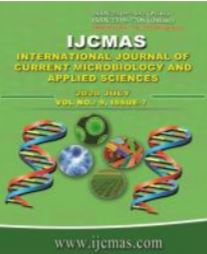


 National Academy of Agricultural Sciences (NAAS)
National Academy of Agricultural Sciences (NAAS)

|
PRINT ISSN : 2319-7692
Online ISSN : 2319-7706 Issues : 12 per year Publisher : Excellent Publishers Email : editorijcmas@gmail.com / submit@ijcmas.com Editor-in-chief: Dr.M.Prakash Index Copernicus ICV 2018: 95.39 NAAS RATING 2020: 5.38 |
It was universally known that in the Indian diet, cereals and millets as well as pulses and legumes do provide minerals like calcium and iron yet, vegetables and fruits were also the major sources of minerals, vitamins and fibre and households tends to neglect their importance in the daily consumption. NSSO (2014) report revealed that average monthly per capita consumer expenditure (MPCE) for Indian citizen stood at ₹ 1984 in urban area and ₹ 1054 in rural India with a share of only ₹175.2 (urban area) and Rs 112.9 (rural area) in fruits and 175.2 (urban area) and Rs 112.9 (rural area) in terms of vegetables. Thus, fruits and vegetables constituted a minor portion of 10.7 per cent (rural) and 8.8 per cent (urban) MPCE. The present paper emphasised on the availability of fruits and vegetables and the gap in the calorie intake of fruits and vegetables among households. Meghalaya was chosen purposively as the area of the study as the state has the highest prevalence to acute malnutrition and has the highest number of stunting children in the country. The state has also the least per capita per day intake of energy which was only 1,686 Kcal in the rural areas and 1,755 Kcal per capita at urban area day in Meghalaya of the 2400 Kcal as prescribed by the ICMR. A total of three districts viz., East Khasi Hills District, West Jaintia hills and West Garo Hills district have been studies with two blocks each with 2 village from each block. 240 farmers were interviewed and the result was documented. It has been found that the availability of fruits and vegetables to the households were mainly from their own farms and market access. In terms of calorie intake among fruits and vegetables it has been found that across each districts, there was a deficit or gap in the calorie intake by 324.71, 308.84 and 294.78 Kcal, respectively with an average deficit by 309.45 Kcal in the state. The study suggests that proper awareness by concerns department had to be initiated towards the importance of fruits and vegetables in the daily diet. As the topography of the state is very suitable for fruits and vegetables, a cluster approach in the development of appropriate crops for certain areas has to be set off by the horticulture institutions for the welfare of the farmers and the farming households as a whole.
 |
 |
 |
 |
 |